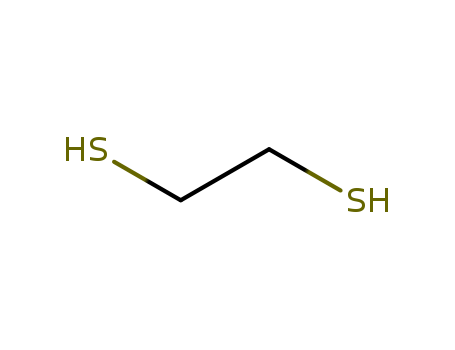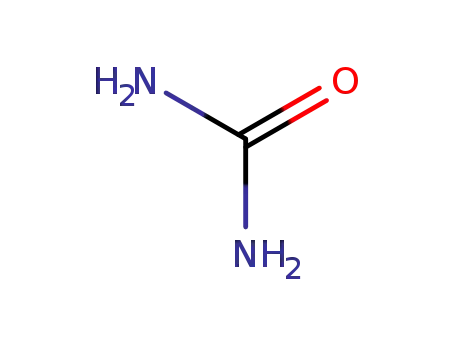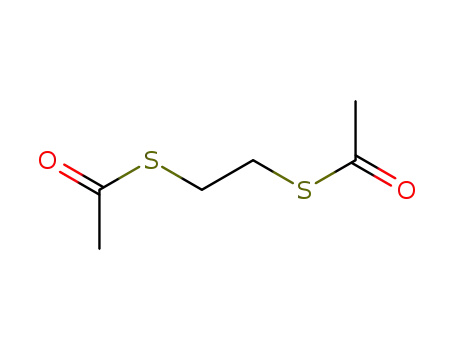Your Location:Home >Products >Fine chemicals >540-63-6


Product Details
|
Description |
1,2-Ethanedithiol (EDT) is a colorless liquid with a characteristic odor that resembles that of rotten cabbage. It is widely used as a building block in organic synthesis, and it is also an effective ligand for metal ions. 1,2-ethanedithiol if applied as a flavoring agent and it is available in a variety of animal foods, in cooked beef and chicken. |
|
Chemical and Physical properties |
1, 2-ethanedithiol (C2H6S2) has a molecular weight of 94.19 g/mol, a monoisotopic mass of 93.991 g/mol and an exact mass of 93.991 g/mol. It has a heavy atom count of 4, a topographical surface area of 2 A^2, and a complexity of 6. EDT has a hydrogen bond donor and acceptor count of 2 and 2 respectively. EDT gas a boiling point of 146 deg C at 760 mm Hg and a melting point of -41.2 °C. It dissolves in benzene, acetone, ether, ethanol and oxygenated solvents, while it is sparingly soluble in alkali. EDT dissolves in water at 1.12X10+4 mg/L at 25 deg C (est). 1,2-ethanedithiol has an extrapolated vapor pressure of 5.61 mm Hg at 25 deg C. When heated, EDT decomposes to emit toxic fumes comprising of sulfur oxides. Its odor is mild at 31 ppb and it gets more noticeable at 5.6 ppm. |
|
Preparation |
1,2-ethanedithiol can be synthesized by reacting an alkali metal hydrosulfide with an alkylene halide. However, this method does not yield a good amount of EDT due to the formation of by-products such as polymeric materials. The formation of these by-products could be reduced by conducting the reaction in an autoclave where the pressure is regulated to H 8. EDT can also be prepared through the decomposition of thiourea and the isothiuronium salt of ethylene bromide. This method yields slightly higher dithiol yields as indicated in the general formula where n is equal to or more than 3, for instance, 1,4-butanedithiol and 1,3-propanedithiol. However, this method also imposes significant constraints in the preparation of lower members of the dithiol series, such as 1,2-ethanedithiol. An additional method for the preparation of the compound entails the reaction between ethylene sulfide and H 8 in methanol, which yields approximately 49% of 1,2-ethanedithiol. However, this method also yields products with a relatively high molecular weight, which account for about 20% of the total products. There is a wide range of other methods that have been suggested for the synthesis of 1,2-ethanedithiol but they have been disqualified based on certain justifications. The process highlighted below entails three major steps: 1) the generation of ethylene sulfide, 2) reaction of ethylene sulfide with hydrosulfide and 3) the liberation of 1,2-ethanedithiol through acid treatment. Z-mercaptoethy-lcarbonate is added to an alkaline solution in the portions highlighted above over a 30-minute period, the pH of the alkaline solution should be above 6.8, where the base is indicated with the general formula MOH, where M indicates an alkali-metal hydroxides such as potassium, lithium or sodium. The contents should also include 1-2 moles of the reacting ammonium hydrosulfide per mole of the alkyl 2-mercaptoethylcarbonate. Stir the reaction contents while maintaining the temperature at -100 C while adding the alkyl portions. The solution can be saturated with hydrogen sulfide by passing the gas through the reaction contents for about 2 hours. The contents should be stirred for a period of 10-20 hours or more while maintaining the temperature at 15300 C. The solution is cooled and reacted with an acid such as phosphoric, sulfuric or hydrochloric acids, and 1,2-ethanedithiol is separated from the mixture through conventional means such as extraction using a volatile solvent such as benzene or chloroform, or by distillation. This step is followed by the evaporation of the contents to remove the solvent. A combination of both processes could be more effective, where the dried product is taken through fractional distillation. This method involving ammonium hydrosulfide and ethyl Z-mercaptoethyl carbonate is highly preferred for the preparation of 1,2-ethanedithiol. |
|
Precautions |
One should wash their hands thoroughly after contact with 1,2-ethanedithiol. It is not recommended to smoke, eat or drink while handling EDT. If ingested, one should contact a doctor immediately or the poison center. In the event of a fire, one should use appropriate apparatus to extinguish the fire. If the chemical comes into contact with one’s clothes or skin, they should take off the clothes and rinse their skin with plenty of water. |
|
Hazard Statements |
1,2-ethanedithiol is a flammable liquid. EDT is toxic when ingested and it may result in acute toxicity. It may cause acute dermal toxicity upon contact with the skin. EDT may result in serious eye irritation/damage and it may also cause acute toxicity upon inhalation. Inhalation of EDT vapours may cause severe nausea or headaches. |
|
Chemical Properties |
Clear colorless solid |
|
Occurrence |
Reported found in beef (boiled, cooked) and chicken (cooked) |
|
Uses |
1,2-Ethanedithiol is used as a reagent in organic synthesis to convert carbonyl compounds to thioacetals (1,3-dithiolanes). It replaces the toxic reagent arsenic tirchloride, which is involved in the synthesis of membrane-permeant fluorogenic biarsenicals from precursor dyes fluorescein and resorufin. It acts bidendate ligand to form complexes with metal ions. |
|
General Description |
1,2-Ethanedithiol (1,2-Dimercaptoethane, Dithioglycol, Ethylene mercaptan) is an organo sulfur compound. It affords monomeric, dimeric and polymeric complexes on reaction with Pt(PPh3)4, Pd(PPh3)4 and Ni(PPh3)4. It has been synthesized by refluxing 1,2-dichloroethane with thiourea in ethanol. |
|
Hazard |
Vapors cause severe headache and nausea. |
|
Safety Profile |
Poison by ingestion, intraperitoneal, and intravenous routes. When heated to decomposition it emits very toxic fumes of SOx. See also MERCAPTANS . |
|
Who Evaluation |
Evaluation year: 1999 |
InChI:InChI=1/C2H4S2/c1-2(3)4/h3-4H,1H2
Thiylation of polyhaloalkanes and Parafo...
A simple procedure was developed for pre...
A new procedure for preparative synthesi...
Heating of benzeneselenol with polymethy...

hydrogenchloride


S,S'-ethylene bis(toluene-p-thiosulphonate)

![[1,2,5,6]tetrathiocane](/upload/2024/4/3ef2294c-5e8d-4aee-b783-aef0d6e07f82.png)
[1,2,5,6]tetrathiocane


p-toluene sulfinic acid


ethane-1,2-dithiol


para-thiocresol
| Conditions | Yield |
|---|---|
|
|

1,3-dithiolan-2-one


ammonia


ethane-1,2-dithiol


urea
| Conditions | Yield |
|---|---|
|
at 100 ℃;
|

thirane

ethene

bis (2-chloroethyl) sulphide

S,S'-ethane-1,2-diyl diethanethioate

2-(2-mercapto-ethylsulfanyl)-ethanol

2,2'-ethane-1,2-diylbissulfanyl-bis-ethanol

1,4,7-trithia-spiro[4.4]nonane

2-methyl-2-(thiophen-2-yl)-1,3-dithiolane
CAS:14867-28-8
CAS:72-14-0
CAS:77086-38-5
CAS:137234-88-9